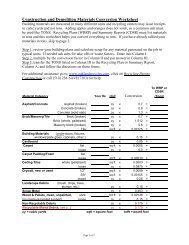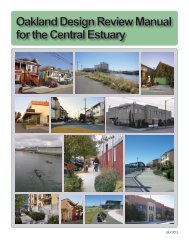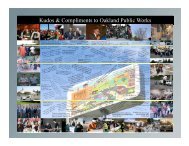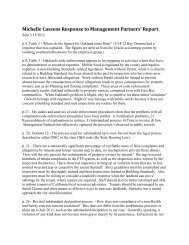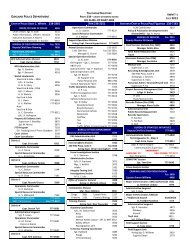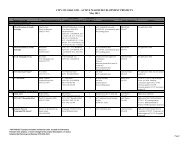Intelligent Transportation Systems - City of Oakland
Intelligent Transportation Systems - City of Oakland
Intelligent Transportation Systems - City of Oakland
Create successful ePaper yourself
Turn your PDF publications into a flip-book with our unique Google optimized e-Paper software.
• Signal Technicians - 5.5 FTE<br />
With an expected increase in the inventory <strong>of</strong> ITS equipment, the emphasis may tend to<br />
shift to responding to malfunctions and failures rather than activities to prevent<br />
malfunctions and failures. To adequately provide preventative and response<br />
maintenance functions, the <strong>City</strong>’s traffic signal maintenance staff will need to be<br />
increased. The <strong>City</strong>’s existing staff feels that an additional 2 FTEs should be adequate<br />
to maintain the anticipated ITS devices and traffic signals. However, based on<br />
experience in other agencies, it is recommended that the <strong>City</strong> ultimately have at least 14<br />
FTEs dedicated to maintenance <strong>of</strong> ITS and traffic signals. This is an increase <strong>of</strong> 8<br />
FTEs over the <strong>City</strong>’s current staffing level. For the near term though, until more ITS<br />
devices and infrastructure are deployed, an additional two FTEs for maintenance should<br />
be adequate.<br />
These staffing recommendations are based on current staffing levels at similar sized<br />
Cities in the Bay Area. For instance, the <strong>City</strong> <strong>of</strong> San Jose, which operates about 800<br />
traffic signals and two dozen CCTV cameras, plus other ITS equipment, has 6 FTEs for<br />
Operations and 17 FTEs for Maintenance. Furthermore, the <strong>City</strong> <strong>of</strong> Menlo Park<br />
recommends one traffic signal technician for every 50 traffic signals and one traffic<br />
signal engineer for every 100 traffic signals to ensure adequate O&M <strong>of</strong> their traffic<br />
signal system. This is a common rule <strong>of</strong> thumb in the traffic industry for determining<br />
O&M staffing requirements. This translates to approximately 14 technicians and 7 traffic<br />
engineers for the <strong>City</strong> <strong>of</strong> <strong>Oakland</strong>’s 700 traffic signals, which is fairly consistent with the<br />
previous recommendations.<br />
For most <strong>of</strong> the ITS elements, the <strong>City</strong> should continue to staff their maintenance and<br />
operations activities with in-house staff. This may require hiring new staff to meet the<br />
recommended staffing levels or shifting <strong>City</strong> staff from other duties. If the <strong>City</strong> has<br />
available maintenance staff but they are in need <strong>of</strong> training before assuming the role <strong>of</strong><br />
system maintenance, the contractor to be awarded the system deployment contract can<br />
be required to provide operational support and training to <strong>City</strong> personnel for a specified<br />
period <strong>of</strong> time. At the end <strong>of</strong> the operational support period, the <strong>City</strong> would assume full<br />
responsibility for the maintenance <strong>of</strong> system. If the <strong>City</strong> does not possess the necessary<br />
resources and is not in a position to commit to long term maintenance <strong>of</strong> the corridors,<br />
contracting <strong>of</strong> maintenance operations is a viable option.<br />
Table 9.3 illustrates some benefits and risks resulting from outsourcing O&M<br />
responsibilities.<br />
Table 9.3 – Outsourcing Benefits and Risks<br />
Outsourcing Benefits<br />
Risks<br />
Clear separation between agency and<br />
contractor responsibilities.<br />
Agency can decide what tasks it wishes<br />
for the contractor to perform with its<br />
own forces.<br />
Little flexibility to get services outside<br />
the specific scope without extensive<br />
administration and additional cost.<br />
Little incentive for the contractor to<br />
exceed performance standards <strong>of</strong><br />
accomplishment criteria.<br />
<strong>City</strong> <strong>of</strong> <strong>Oakland</strong> ITS Strategic Plan<br />
115 September, 2003







